
Lecture 20: From Protostars to the Main Sequence
Recall that stars form from collapsing clouds and that we have plenty of evidence that stars are currently forming in the Milky Way (and in other galaxies, too!).

Stellar Lifetimes

This gives the lifetime in years. Recall the relations between mass and luminosity for a stars:
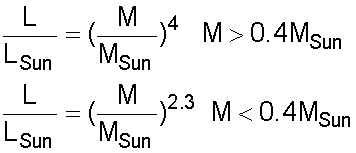
If we use the mass-luminosity relation for stars of 0.4MSun and greater,

or 
so a star with 10x the mass of the Sun will have a main sequence lifetime of only 10 million yrs!
So we know that O stars, the most massive stars, have main sequence lifetimes of only a million years so the fact that we see some O stars now means that star formation is still occuring in the Milky Way.
The Star Formation Process
From a variety of observations, it appears certain that stars form in the centers of dense molecular clouds.
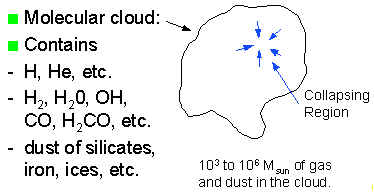
--- clouds have cores which are hotter and denser than the surrounding material suggesting that the cloud is collapsing in its core.
-- Generally speaking, we think most star formation proceeds along the same lines as the formation of the Solar System:
1) A cold, dense molecular cloud begins to collapse
{ collapse may be triggered by gravity, a supernova blast, nearby hot stars}
2) Cloud fragments into stellar-sized clumps
3) Stars form in these clumps; planets may or may not form in the cloud material surrounding the star
Step 1: initial collapse
[Abundances of some rare isotopes found in meteorites suggest that this was the triggering mechanism for the collapse of the cloud that became the Solar System]
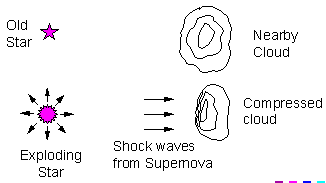
Step 2: the GMC begins to collapse and it fragments into subcondensations which form individual stars. Although we don't know exactly why clouds like to fragment, it is obviously a common occurrence given the number of star clusters we see. It appears to be related to turbulence in the collapsing cloud.

Step 3: The clump collapses into a star
Consider the balance of forces in the collapsing cloud by looking at a gas sample in the cloud:
Gravity pulls gas towards the cloud center:
Fgrav = GMcloudmgas/r2
r=distance from cloud center
Fpressure = C x density x T
T = temperature
While T is low (cloud is cool),
Fgrav > Fpressure
and cloud collapses.
This collapse happens very fast. Eventually the gas gets sufficiently compressed that it is dense and hot enough that
Fpressure > Fgrav
and the collapse stops.
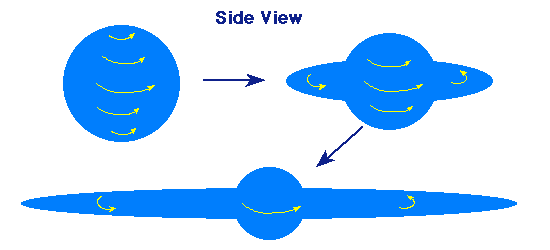 The star is likely to be surrounded by gas and dust leftover from its formation, usually in the form of a circumstellar disk shape. The circumstellar disks are where planets form.
The star is likely to be surrounded by gas and dust leftover from its formation, usually in the form of a circumstellar disk shape. The circumstellar disks are where planets form.
Many clouds in the galaxy cannot collapse to form stars because their temperatures are too high --
Cloud will collapse only if their gravitational force can overcome their internal pressure.
Recall from the lecture on the Sun that this equilibrium is fulfilled if

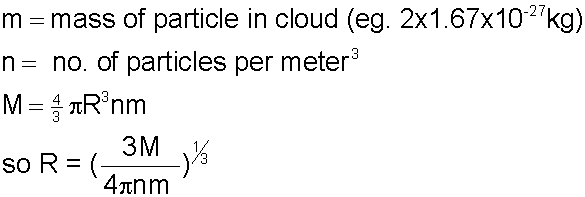


named for Sir James Jeans. Clouds of larger mass than the Jeans mass can collapse while smaller ones cannot.
For a typical interstellar cloud with T=50°K and n =106 particles/m3,

while for a dense cloud core with T=10°K and n=1012 particles/m3:

During the initial parts of its contraction, a cloud won't heat up -- radiation escapes and carries away the energy. The Jeans mass decreases because T is staying constant but the density is increasing. Eventually the cloud breaks into fragments which in turn collapse to become stars.
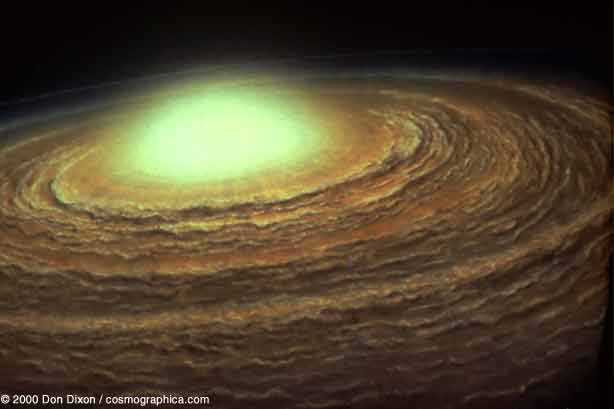 An artist's idea of what the formation of the sun might have looked like.
An artist's idea of what the formation of the sun might have looked like.
Eventually the star will blow way the material surrounding it and become a regular visible star.
Cloud clumps with .08 M![]() < M < 100 M
< M < 100 M![]() can form stable, main sequence stars.
can form stable, main sequence stars.
--- after initial collapse, protostar is likely still to be surrounded by remnant of the cloud from which it formed (need to observe at long wavelengths to see through the dust)
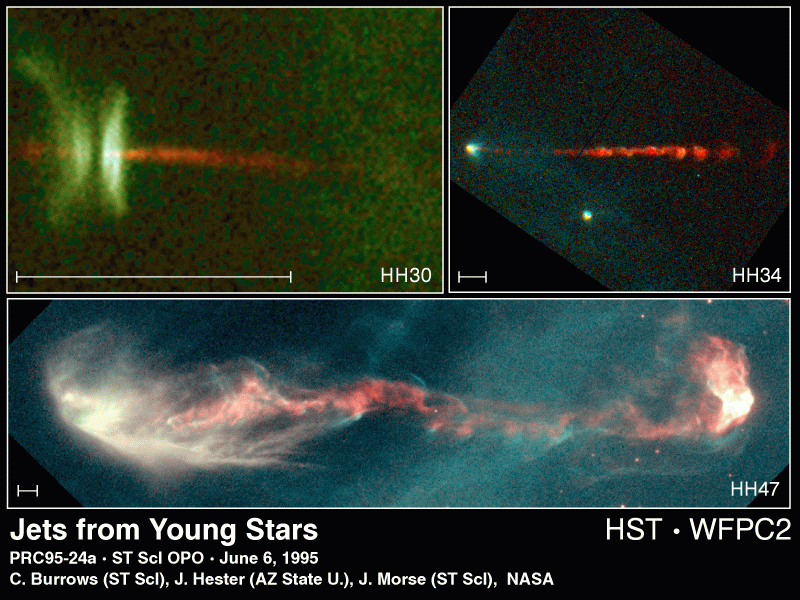
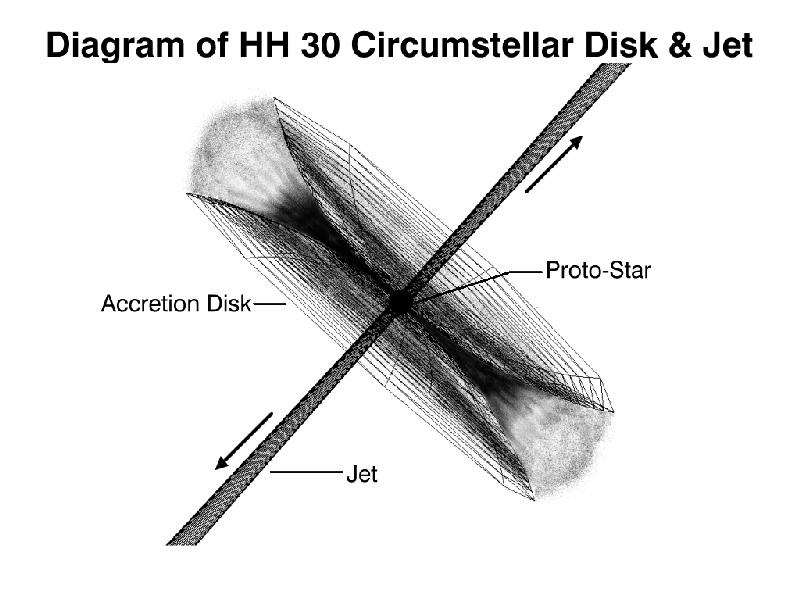
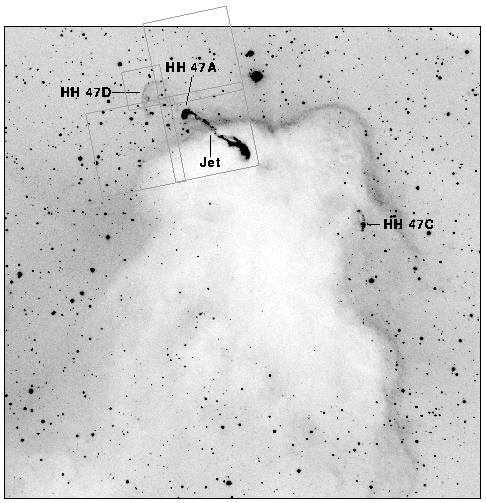
What happens if the collapsing cloud is too large?
If the mass of the cloud exceeds about 100 M![]() , it will collapse and heat up very quickly. Nuclear reactions occur so rapidly that the star becomes very luminous and blows itself apart -- either catastrophically or more gently by blowing off only the outer layers.
, it will collapse and heat up very quickly. Nuclear reactions occur so rapidly that the star becomes very luminous and blows itself apart -- either catastrophically or more gently by blowing off only the outer layers.
If the cloud has M < .08 M![]() , it will contract, heat up, but the central temperature will never reach the 10,000,000°K limit required to start the conversion of H to He. The outer layers may get as hot as 2500°K and so appear similar to cool, dim stars, but they will have only a very brief lifetime in this luminous state. Such objects are called brown dwarfs.
, it will contract, heat up, but the central temperature will never reach the 10,000,000°K limit required to start the conversion of H to He. The outer layers may get as hot as 2500°K and so appear similar to cool, dim stars, but they will have only a very brief lifetime in this luminous state. Such objects are called brown dwarfs.
Initial Mass Function
By observing the relative numbers of various masses of stars, we have been able to deduce something about the cloud fragmentation process even though we do not understand the details theoretically. The initial mass function (IMF) describes the relative numbers of each stellar mass:

Example of using this relationship:
Consider a cloud with a total mass of 1000MSun . How many 10MSun stars are formed if it follows the above IMF and forms stars over a range from 1 to 50MSun ?
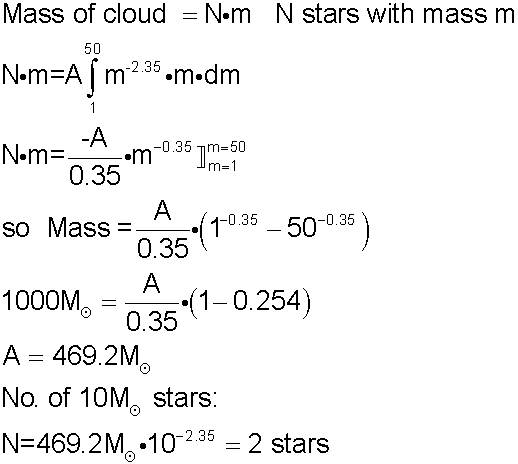
Note that this is the number of stars with 10MSun in an interval of 1MSun .
After a cloud has contracted sufficiently, these steps describe its path to the main sequence:

Color Magnitude diagram for the cluster NGC2264
The track of where stars of different masses hit the main sequence is called the zero age main sequence.
Stars on the Main Sequence
While on the main sequence, a star is very stable, but its properties are slowly changing as the result of the composition of its core changing. For example, since P=nkT the pressure of the gas will respond to the smaller value of n because 4 H atoms have gone into one He atom. T increases to maintain hydrostatic equilibrium which in turn causes the luminosity to increase slightly.
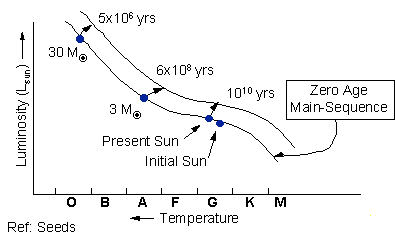
Eventually the H loss is too large for the core to maintain hydrostatic equilibrium because the rate of energy generation drops due to a lack of H.
